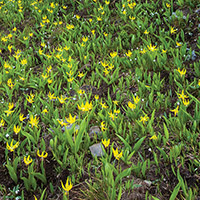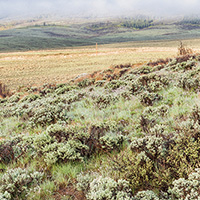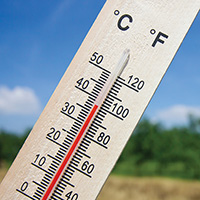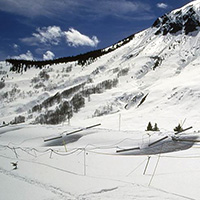
Colorado’s Warming Meadow
On The Ground
For almost a quarter of a century, Energy and Resource Group (ERG) professor John Harte and his students have been artificially warming a meadow at the Rocky Mountain Biological Laboratory in Colorado and watching it change and decline in biodiversity. The extraordinary length and prescience of the project, launched 16 years before Al Gore won the Nobel Prize for his film and education campaign on climate change, has yielded novel information about the impact of global warming. Harte, who is also affiliated with the Department of Environmental Science, Policy, and Management, is a physicist-turned-ecologist focusing on global change ecology and spatial patterns of species distributions.
The Experiment
Running continuously since 1991, the warming meadow is the world’s longest operating controlled experiment on climate change, baking an existing, ungrazed subalpine meadow with large electric heaters. The experiment consists of ten adjacent plots, with half serving as a control. Heaters hang above the other five plots, exposing plants, animals, microbes, and soil to a climate resembling what the entire region is projected to experience by 2050. Every two hours, the soil temperature and moisture are measured at various depths.
Encroaching Sagebrush
At the start, both heated and unheated plots were dominated by forbs—non-woody flowering plants, such as glacier lilies and larkspur—and dotted with occasional sagebrush. Just a few years into the experiment, Harte and Rebecca Shaw, PhD ’97, ERG, reported in the journal Science that the above-ground biomass of Artemisia tridentata (a sagebrush) increased, while the forb biomass decreased.
Brightness Cools; Darkness Warms
The doubling of the atmospheric concentration of carbon dioxide (CO2, the greenhouse gas primarily responsible for climate warming) was shifting the meadow habitat to less-reflective woody sagebrush, the pair reported in the Science article. Whereas the light-colored flowers reflect the sun’s energy back into the atmosphere, the darker sagebrush bark absorbs it, making the meadow even warmer and providing the conditions for more sagebrush, ultimately crowding out the forbs. Similar to the melting of the polar ice caps, the loss of mountain meadows is both an indicator of global warming and a contributing cause.
The Carbon Cycle
Wildflowers are active photosynthesizers, taking carbon from the atmosphere and converting it to leaves, flowers, and stems. In the fall, they shed the above-ground material. The decomposing plant material enters the soil, where microbes change it back into CO2 to reenter the atmosphere, maintaining a balanced cycle of taking CO2 out of the atmosphere and releasing it in equal measure. By comparison, sagebrush is less active at photosynthesis and produces far less plant material. As the sagebrush spread on the heated plots, the CO2 in the soil continued to be released by microbes, but was no longer being replaced. The meadow, once at carbon equilibrium, has become a carbon emitter.
Ecological Feedback Loops
Encroaching sagebrush causes a cascade of reinforcing changes, with warming leading to more warming. A small increase in temperature leads to an increase of CO2, which in turn leads to even higher temperatures and more CO2. Climate change begins the process, but feedbacks accelerate it. These biological feedbacks are not factored into global warming models. If they were, the upper-limit increase in global temperature currently projected by 2050 would be closer to 10 degrees Fahrenheit, not 6 degrees.
Feeling the Heat
The responses to the warmed environment have been dramatic. Spring comes weeks earlier because the snow melts faster, and the soils are hotter and drier than in the unheated plots. The warmer weather affects plant reproductive cycles and duration, both for late- and early-blooming species, from bud formation to seed dispersal. Between 1990 and 2010, heated plots lost about a fourth of all the organic carbon formerly stored in the soil; it was released into the atmosphere as CO2.
Control Plots Are Catching Up
In a 2014 article submitted for publication, Harte, Scott R. Saleska, PhD Energy and Resources ’98, and biologist Charlotte Levy noted that the control plots, due to climate-induced reduced snowpack and earlier snowmelt, are now slowly exhibiting the same patterns of change seen in the heated plots, with woody plants replacing forbs and altering soil carbon sources and sinks, confirming many of the observations and findings of the long-running experiment.
Revising Warming Predictions
The study’s key finding so far: The ways in which ecosystems alter the climate exacerbate warming. It is increasingly important to include these transformations when predicting the effects of climate change, Harte says. He emphasizes that this experiment is crucial for understanding the causal processes linking local climate and vegetation and how these factors influence the carbon cycle.






